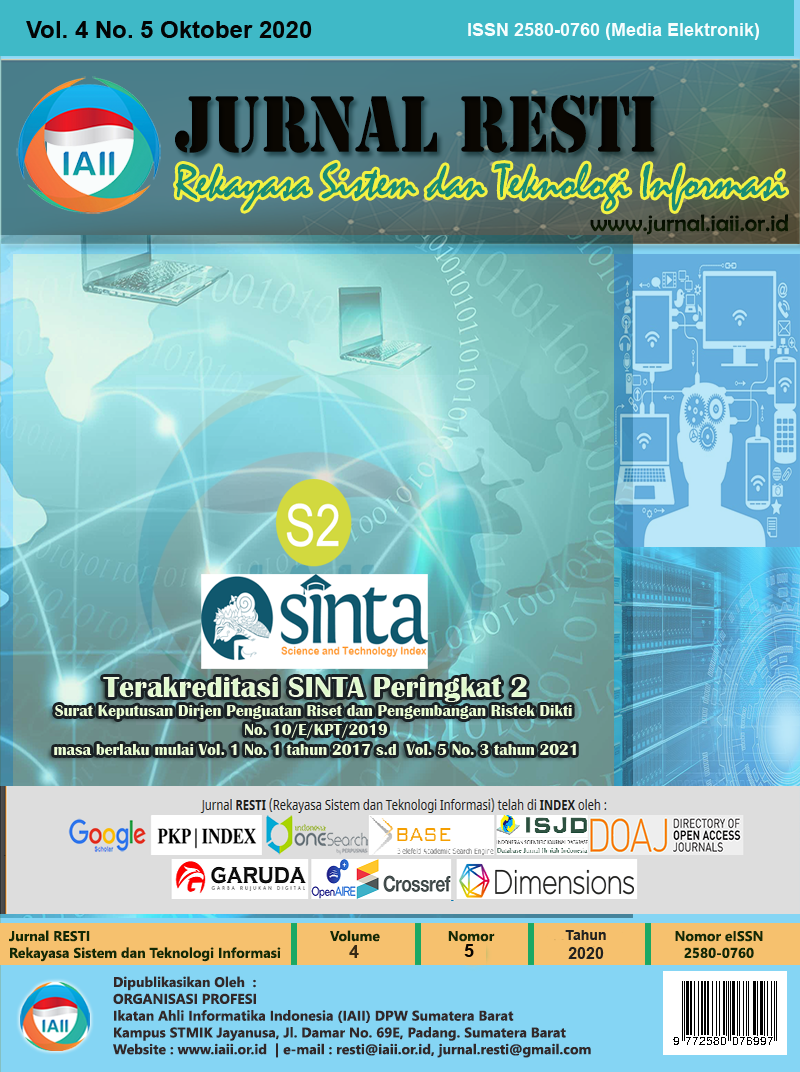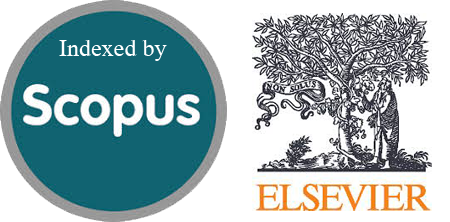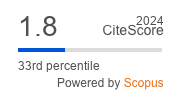Analisis Node dengan Centrality dan Follower Rank pada Twitter
Abstract
Twitter is used to express about something that happened. In Indonesia since 2012, Twitter has been widely used for campaigns during regional or presidential elections. Apart from positive campaigns, negative campaigns and even black campaigns were carried out via Twitter, and tweets become twitwar. Twitter is a social network, so the data can be analyzed using a social network analysis approach. This research was conducted to analyze which nodes (actors) are influential using the degree, between, and closeness centrality methods, while the follower rank method is used for the analysis of popular actors in "# 4niesKingOfDrama". The data were 8895 nodes with 23257 edges taken from January 1 to February 20, 2020. The results showed that Degree Centrality was 212 with the actor who had the highest influence score was the account @ Bangsul__88 and actor @airin_nz was the actor with the highest popularity value with Follower Rank of 0.98211783. This study found that among the 10 main actors with the highest Degree Centrality values, there were several accounts that were buzzer accounts. The node (Actor) with the highest influence value is not necessarily the node with the highest popularity value.
Downloads
References
Kapoor, K.K., Tamilmani, K., Rana, N.P. et al. Advances in Social Media Research: Past, Present and Future. Inf Syst Front 20, 531–558 (2018). https://doi.org/10.1007/s10796-017-9810-y
APJII, “Survei APJII: Penetrasi Internet di Indonesia Capai 143 Juta Jiwa,” Buletin Asosiasi Penyelenggara Jasa Internet Indonesia, vol. Edisi-22 2. p. 3, 2018.
S. Alhabash and M. Ma, “A Tale of Four Platforms: Motivations and Uses of Facebook, Twitter, Instagram, and Snapchat Among College Students?,” Soc. Media Soc., vol. 3, no. 1, 2017, doi: 10.1177/2056305117691544.
M. A. Firmansyah, “Kontestasi Pesan Politik dalam Kampanye Pilpres 2014 di Twitter : Dari Kultwit Hingga Twitwar,” J. Ilmu Komun., vol. 16, no. 1, pp. 42–53, 2018.
M. A. Firmansyah, S. Karlinah, and S. Sumartias, “Kampanye Pilpres 2014 dalam Konstruksi Akun Twitter Pendukung Capres,” J. Messenger, vol. 9, no. 1, p. 79, 2017, doi: 10.26623/themessenger.v9i1.430.
A. Budiman, U. Pemilu, G. Mada, and A. Sujito, “Kampanye Hitam Pemilu Presiden 2014,” vol. VI, no. 11, 2014.
E. Khoirunisa, R. Karsidi, and M. Yusuf, “The Interactivity of Twitwar among Social Media Influencer and Followers on Twitter,” Int. J. Multicult. Multireligious Underst., no. 34, pp. 282–289, 2019.
DW, “Indonesia: Deadly flood forces tens of thousands to leave Jakarta,” 2020. [Online]. Available: https://www.dw.com/en/indonesia-deadly-flood-forces-tens-of-thousands-to-leave-jakarta/a-51855305.
The Jakarta Post, “Flights disrupted, trains delayed as massive floods hit Jakarta,” 2020. [Online]. Available: https://www.thejakartapost.com/news/2020/01/01/flights-disrupted-trains-delayed-as-massive-floods-hit-jakarta.html.
F. Bloch and M. O. Jackson, “Centrality Measures in Networks,” SSRN Electron. J., 2016, doi: 10.2139/ssrn.2749124.
F. Riquelme and P. González-Cantergiani, “Measuring user influence on Twitter: A survey,” Inf. Process. Manag., vol. 52, no. 5, pp. 949–975, 2016, doi: 10.1016/j.ipm.2016.04.003.
A. S. Badashian and E. Stroulia, “Measuring user influence in Github: The million follower fallacy,” Proc. - 3rd Int. Work. CrowdSourcing Softw. Eng. CSI-SE 2016, pp. 15–21, 2016, doi: 10.1145/2897659.2897663.
J. Zhang and Y. Luo, “Degree Centrality, Betweenness Centrality, and Closeness Centrality in Social Network,” vol. 132, no. Msam, pp. 300–303, 2017, doi: 10.2991/msam-17.2017.68.
S. P. Borgatti and M. G. Everett, “A Graph-theoretic perspective on centrality,” Soc. Networks, vol. 28, no. 4, pp. 466–484, 2006, doi: 10.1016/j.socnet.2005.11.005.
A. I. Sugiarta, D. Syamsuar, and E. S. Negara, “Analisis Sentralitas Aktor pada Struktur Jaringan Politik dengan Menggunakan Metode Social Network Analysis ( SNA ) : Studi Kasus Group Facebook Lembaga Survei Sosial Media,” Semnastik, pp. 1–7, 2018.
Enos JR, Nilchiani RR. "Understanding the importance of expanding the definition of interoperability through social network analysis". Systems Engineering. 2019;1- 15 doi: https://doi.org/10.1002/sys.21500
M. Jacomy, T. Venturini, S. Heymann, and M. Bastian, “ForceAtlas2, a continuous graph layout algorithm for handy network visualization designed for the Gephi software,” PLoS One, vol. 9, no. 6, pp. 1–12, 2014, doi: 10.1371/journal.pone.0098679.
Ma, F., Wang, X., & Wang, P. (2020). Counterexample: scale-free networked graphs with invariable diameter and density feature. ArXiv, abs/2001.03525.
Copyright (c) 2020 Jurnal RESTI (Rekayasa Sistem dan Teknologi Informasi)

This work is licensed under a Creative Commons Attribution 4.0 International License.
Copyright in each article belongs to the author
- The author acknowledges that the RESTI Journal (System Engineering and Information Technology) is the first publisher to publish with a license Creative Commons Attribution 4.0 International License.
- Authors can enter writing separately, arrange the non-exclusive distribution of manuscripts that have been published in this journal into other versions (eg sent to the author's institutional repository, publication in a book, etc.), by acknowledging that the manuscript has been published for the first time in the RESTI (Rekayasa Sistem dan Teknologi Informasi) journal ;








